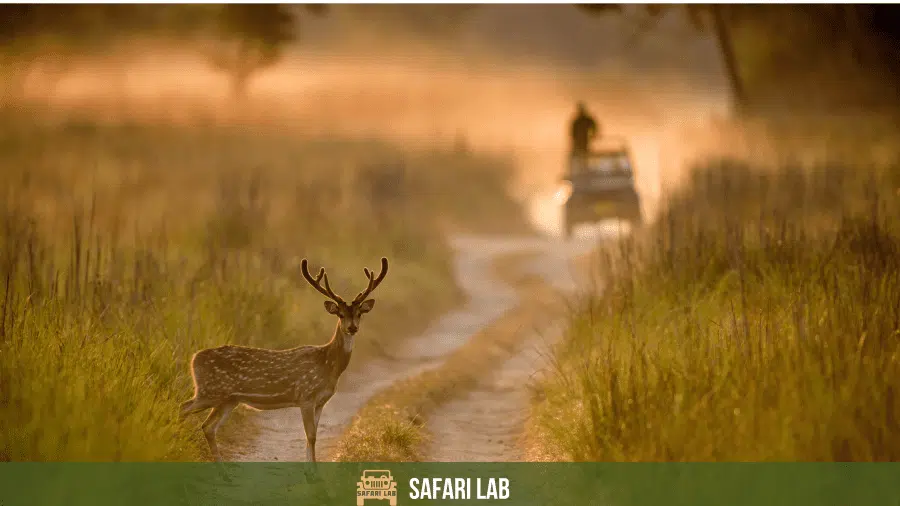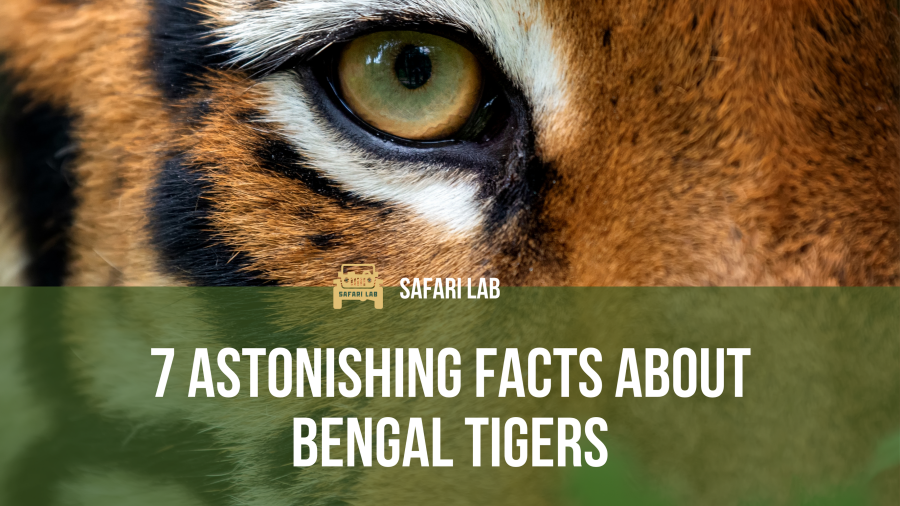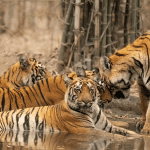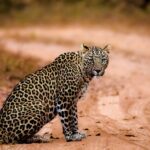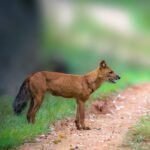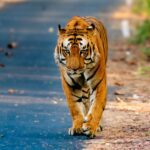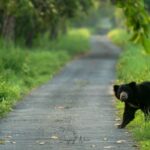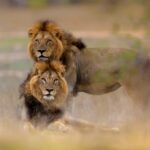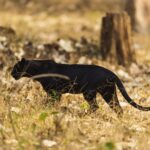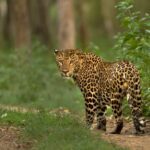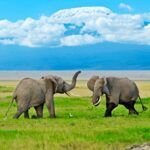The black leopard, also known as the black panther, is a rare and captivating species of leopard. Its dark fur, caused by a genetic condition called melanism, sets it apart from its more commonly spotted counterparts. The black leopard’s unique appearance and adaptations have fascinated people for centuries, leading to its portrayal in popular culture and myths. However, it is important to understand that the black leopard is not a separate species but a fascinating color variation within the leopard species.
Key Takeaways:
- The black leopard, also known as the black panther, is a rare and captivating species of leopard.
- Melanism is a genetic condition that causes the dark fur coloration in black leopards.
- Black leopards are not a separate species but a color variation within the leopard species.
- The black leopard’s unique appearance and adaptations have led to its portrayal in popular culture and myths.
- Understanding the truth behind the myth of the black panther is crucial for conservation efforts and the appreciation of biodiversity.
Jump To
ToggleThe Origins of the Black Leopard
The black leopard’s distinctiveness stems from a genetic condition called melanism, which results in an overproduction of melanin in its skin and fur. This excess melanin gives the black leopard its striking black fur coloration. Despite its seemingly uniform black appearance, the black leopard still retains the characteristic spots of a leopard, albeit in a less visible manner against the dark background. However, under certain lighting conditions, these spots can still be seen, adding a touch of hidden beauty to the black leopard’s coat.
| Genetic Condition | Excess Melanin Production | Black Fur Coloration |
|---|---|---|
| Black leopard’s distinctive appearance is a result of the genetic condition called melanism. | Melanism leads to the excessive production of melanin in the skin and fur. | The surplus melanin gives the black leopard its characteristic black fur coloration. |
Melanistic Leopards
Melanistic leopards, or black leopards, are fascinating creatures that inhabit the lush jungles of Africa and Asia. With their dark coat, they possess a remarkable ability to blend seamlessly into their surroundings, making them highly efficient hunters. Despite their black appearance, these majestic creatures retain the characteristic spots of regular leopards. These spots, although less visible against the dark background, can be observed under certain lighting conditions, particularly on the head, neck, and rear legs.

The dark coloration of the fur is attributed to the surplus of melanin pigment, which determines the skin and hair color of animals. This excessive melanin production results from a genetic condition known as melanism. Through this adaptation, melanistic leopards demonstrate their evolutionary prowess in the art of camouflage, allowing them to stalk their prey stealthily and remain hidden from potential predators.
Melanistic Jaguars
Similar to black leopards, melanistic jaguars, or black jaguars, can also be found in the dense rainforests of the Americas. These majestic creatures have a jet-black coat with occasional rosettes, the characteristic spots of non-melanistic jaguars. The presence of black jaguars is a testament to the wonders of genetic diversity within the species. Their dark coloration allows them to blend into the shadows of the rainforest and enhances their hunting capabilities.
Black jaguars are well-adapted to their habitat in the rainforests of the Americas. Their stealthy black fur helps them remain camouflaged amidst the dense foliage, enabling them to stalk their prey effectively. The occasional rosettes on their coat provide a subtle pattern, adding to their beauty while maintaining their ability to blend into the shadows.
Genetic diversity plays a crucial role in the survival and evolution of species, and black jaguars are a prime example of this. Their melanistic coat is the result of a genetic variation that provides them with a distinct advantage in their environment. By blending seamlessly with their surroundings, black jaguars can surprise their prey and maintain the element of surprise.
Roaming the Rainforests
Black jaguars are primarily found in the rainforests of Central and South America. These lush and diverse habitats provide them with abundant prey and ample hiding places. They are skilled climbers, using their powerful legs and sharp claws to navigate the trees with ease. Their ability to swim also allows them to traverse rivers and waterways in search of food or to establish new territories.
As apex predators, black jaguars play a vital role in maintaining the balance of their ecosystem. By keeping herbivore populations in check, they prevent overgrazing and ensure the health of the rainforest. Their presence in the rainforests of the Americas is not only a testament to their adaptability but also a reminder of the intricate web of life that exists within these lush environments.

Behold the beauty of a melanistic jaguar in the rainforest, with its sleek black coat and piercing eyes. This image captures the elusive nature and powerful presence of these magnificent creatures in their natural habitat.
| Characteristics of Melanistic Jaguars | Regular Jaguars |
|---|---|
| Jet-black coat with occasional rosettes | Base coat color varies from orange to golden |
| Enhanced camouflage in rainforest environments | Camouflage in grasslands and open habitats |
| Genetic variation resulted in melanism | Non-melanistic coat color variation |
| Play a vital role in rainforest ecosystem | Top predators in their respective habitats |
As seen in the table above, melanistic jaguars possess unique characteristics that set them apart from their non-melanistic counterparts. Their jet-black coat and ability to blend into the rainforest environment highlight their extraordinary adaptations.
Conservation Significance
Understanding the truth behind the myth of the black panther is not only fascinating but also crucial for conservation efforts. By appreciating the unique beauty and adaptations of black leopards and jaguars, we can better protect these magnificent creatures and their habitats. Conservation organizations play a vital role in preserving the biodiversity of these species and educating the public about their importance. Many black leopards and jaguars have been rescued from the exotic pet trade and now reside in accredited sanctuaries where they receive proper care and protection.
| Conservation efforts | Protecting habitats | Preserving biodiversity | Captive black leopards and jaguars |
|---|---|---|---|
| Conservation organizations work tirelessly to safeguard black leopards and jaguars through various initiatives. | Preserving the natural habitats of these species is crucial to their survival and maintaining the delicate balance of ecosystems. | Promoting biodiversity ensures the interconnectedness of different species, contributing to the overall health of the planet. | Captive black leopards and jaguars have found refuge in accredited sanctuaries, providing them with the care and protection needed for their well-being. |
| Organizations collaborate with local communities and governments to establish protected areas and implement effective conservation strategies. | Efforts focus on reducing deforestation, human encroachment, and habitat destruction that threaten the natural habitats of black leopards and jaguars. | Conservation efforts not only benefit black leopards and jaguars but also contribute to the preservation of other endangered species and the overall biodiversity of the region. | Sanctuaries play a vital role in rehabilitating rescued black leopards and jaguars, providing them with a safe and suitable living environment. |
| Education and awareness programs aim to engage the public in understanding the importance of black leopard and jaguar conservation. | Efforts are made to minimize human-wildlife conflict and promote sustainable practices that coexist with the natural habitats of these species. | Preserving biodiversity ensures the long-term resilience of ecosystems, allowing flora and fauna to thrive. | Sanctuaries focus on the rehabilitation and reintroduction of captive black leopards and jaguars back into the wild whenever possible. |
Black Panthers in Popular Culture
Black panthers hold a significant place in popular culture, being featured in various myths, legends, and cultural symbols. These enigmatic creatures have intrigued people across different civilizations, symbolizing strength, agility, and mystery. The allure and mystique surrounding black panthers make them a compelling subject for literature, movies, and art.
In pop culture, the term “black panther” often refers to a superhero character, known for their exceptional abilities and striking appearance. One iconic example is the Marvel superhero, Black Panther, who made his comic book debut in 1966. This character, created by Stan Lee and Jack Kirby, represents the fictional African nation of Wakanda and has since become a symbol of black empowerment and representation.
Black panthers have also been associated with symbolism in various cultures. In some myths and legends, they are seen as guardians or protectors. Their dark fur and stealthy nature evoke notions of mystery and secrecy. Black panthers have been revered as symbols of courage, agility, and adaptability, often revered for their ability to navigate the darkness and overcome challenges.
“The black panther, with its dark and mysterious presence, has always held a special place in our imagination. It represents the untamed spirit, the hidden strength within us all”
It is important to note that the depictions of black panthers in popular culture should be distinguished from the reality of melanistic leopards and jaguars found in the wild. While the fictional portrayals often imbue these creatures with superhuman qualities, the actual beauty and wonder of black panthers lie in their natural adaptations and survival strategies.

Below is a table summarizing the different representations of black panthers in popular culture:
| Popular Culture | Representations |
|---|---|
| Literature | Black panthers are often depicted as mysterious and powerful creatures, associated with symbolism and mythological significance. |
| Movies | Black panthers frequently appear as captivating characters, embodying strength, agility, and heroism. |
| Art | Black panthers serve as visually striking subjects, symbolizing power, beauty, and the enigmatic nature of the wild. |
While popular culture embraces the symbolism and mythology surrounding black panthers, it is essential to appreciate the real-life wonders of these melanistic leopards and jaguars in their natural habitats. By understanding their adaptations, behavior patterns, and the conservation efforts required to protect them, we can ensure the preservation of these magnificent creatures for generations to come.
Black Panthers in their Natural Habitat
Black panthers, which include both leopards and jaguars, are highly adaptable creatures that inhabit diverse habitats across the globe. In the African and Asian jungles, black leopards thrive amidst the lush vegetation, utilizing their dark fur to camouflage themselves and stalk prey in the shadows. Meanwhile, in South and Central American rainforests, black jaguars roam, benefiting from their black coats to blend seamlessly into the dense vegetation.
These magnificent black panthers have successfully adapted to their respective environments, showcasing remarkable behavior patterns and survival strategies. Displaying solitary hunting habits, they rely on their unparalleled stealth, agility, and keen senses to capture prey in their natural habitats.
Black panthers are skilled climbers, able to effortlessly ascend trees and maneuver across tree branches to gain a strategic advantage over their prey. They are also highly proficient swimmers, allowing them to traverse bodies of water with ease when the need arises. Their powerful legs and agile bodies enable them to run swiftly, making them formidable hunters in a variety of landscapes.
In India, the black panther is spotted in Pench Tiger Reserve, Tadoba National Park and Kabini.
These extraordinary black panthers thrive in different environments, embodying the remarkable adaptability of this species. Let’s explore the intriguing behavior patterns and unique characteristics of black panthers, shedding light on their existence and the essential role they play in maintaining the delicate balance of their ecosystems.
Adaptability in the African and Asian Jungles
In the lush African and Asian jungles, black leopards find their ideal habitat. The dense vegetation and abundant prey provide a rich hunting ground for these stealthy predators. With their black fur acting as a natural camouflage, black leopards expertly blend into the shadows, allowing them to approach their unsuspecting prey undetected.
Black leopards’ solitary hunting behavior allows them to stealthily stalk their prey, observing their surroundings and patiently awaiting the opportune moment to strike. This self-reliance and adaptability ensure their survival in the challenging jungles.
Behavior Patterns in South and Central American Rainforests
The rainforests of South and Central America offer a different environment for black panthers, particularly black jaguars. Their black coat enables them to effortlessly blend into the dense foliage, remaining virtually invisible to unsuspecting prey.
Black jaguars, like their leopard counterparts, exhibit solitary hunting behavior. They employ their powerful muscular bodies, sharp claws, and stealth to silently pursue and ambush their prey. The adaptability of black jaguars allows them to thrive in the challenging rainforest terrain, utilizing their unique set of skills to capture their next meal.
Threats to Black Panther Conservation
Black panthers, like many other wildlife species, face numerous threats to their survival. Habitat loss due to human encroachment and deforestation poses a significant risk to their populations. Additionally, poaching for their valuable fur and body parts, driven by the illegal wildlife trade, further endangers black panthers. Conservation efforts focused on habitat protection, anti-poaching measures, and public awareness campaigns are essential for safeguarding these magnificent creatures and ensuring their long-term survival.
Conclusion
The black leopard, with its captivating dark coat and unique adaptations, has long fascinated humans. This magnificent species, sometimes referred to as the black panther, showcases the wonders of melanism, a genetic condition that results in the production of excess melanin, giving rise to their striking black fur.
Understanding the truth behind the mystique of black leopards is crucial for conservation efforts and the appreciation of biodiversity. By protecting their habitats, such as the African and Asian jungles they call home, we can ensure the survival of these remarkable creatures. Additionally, raising awareness about their existence and dispelling prevalent myths surrounding black panthers further empowers us in our conservation endeavors.
As we celebrate their beauty, let us be inspired to foster a sense of responsibility for wildlife conservation. By safeguarding the habitat and preserving the black leopard’s place in the natural world, we not only protect a species but contribute to the greater appreciation and understanding of biodiversity. Together, we can ensure that future generations continue to enjoy and admire the captivating mystique of black leopards and the wonders of the natural world.
FAQ
What is a black leopard?
A black leopard, also known as a black panther, is a rare color variation within the leopard species. It has a dark coat caused by a genetic condition called melanism.
Is the black leopard a separate species?
No, the black leopard is not a separate species but a unique color variation within the leopard species. It retains the characteristic spots of a leopard, although they may be difficult to see against the dark background of its fur.
Where are black leopards found?
Black leopards, or melanistic leopards, are found in the jungles of Africa and Asia. Their dark fur provides excellent camouflage, allowing them to be efficient hunters.
Do black leopards have spots?
Yes, black leopards still retain the characteristic spots of regular leopards. These spots can be seen under certain lighting conditions, especially on the head, neck, and rear legs.
Where are black jaguars found?
Black jaguars, or melanistic jaguars, are found in the dense rainforests of the Americas. Their jet-black coat is occasionally marked by rosettes, the characteristic spots of non-melanistic jaguars.
Why are black panthers important for conservation?
Understanding the truth behind the myth of the black panther is important for conservation efforts and the appreciation of biodiversity. By protecting their habitats and dispelling myths, we can ensure the survival of black leopards and jaguars.
Are black panthers depicted in popular culture?
Yes, black panthers have been featured in myths, legends, and cultural symbols across different civilizations. In pop culture, the term “black panther” is often used to refer to a superhero character.
What threats do black panthers face?
Black panthers, like many other wildlife species, face threats such as habitat loss due to human encroachment and deforestation, as well as poaching driven by the illegal wildlife trade.
How can we protect black panthers?
Conservation efforts focused on habitat protection, anti-poaching measures, and raising public awareness are essential for safeguarding black panthers and ensuring their long-term survival.


